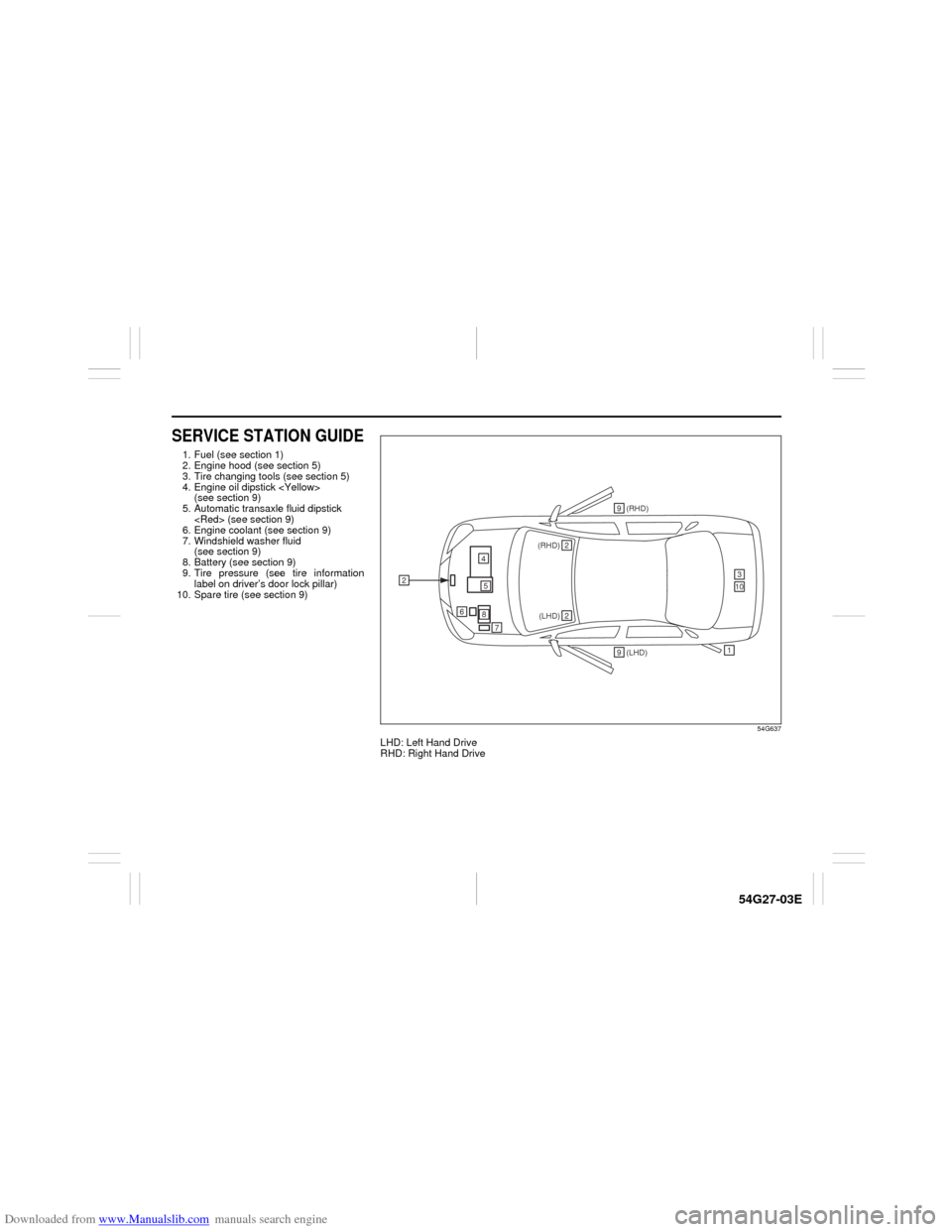2007 SUZUKI AERIO low oil pressure
[x] Cancel search: low oil pressurePage 1 of 232

Downloaded from www.Manualslib.com manuals search engine Part No. 99011-54G27-03E
June, 2006
OWNER’S MANUAL
99011-54G27-03E AERIO
Printed in Japan
See page 1-1
10.0 mm
Keep With Vehicle At All Times.
Contains Important Information
On Safety, Operation & Maintenance.
SERVICE STATION INFORMATION
Fuel recommendation: Brake and clutch fluid:
Engine oil recommendation: Automatic transaxle fluid:
Tire cold pressure:
For further details, see “Engine Oil and Filter” in the
“INSPECTION AND MAINTENANCE” section.DOT3
An equivalent of DEXRON®
-III.
See the “Tire Information Label” located on the
driver’s door lock pillar.
2007Engine oil with “Starburst” symbol
Made from 100% recycled paper,
except for cover.
ENGLISH
Suzuki Red: Magenta 100%, Yellow 100%
Suzuki Blue: Cyan 100%, Magenta 70%
Page 4 of 232

Downloaded from www.Manualslib.com manuals search engine 54G27-03E
SERVICE STATION GUIDE1. Fuel (see section 1)
2. Engine hood (see section 5)
3. Tire changing tools (see section 5)
4. Engine oil dipstick
(see section 9)
5. Automatic transaxle fluid dipstick
6. Engine coolant (see section 9)
7. Windshield washer fluid
(see section 9)
8. Battery (see section 9)
9. Tire pressure (see tire information
label on driver’s door lock pillar)
10. Spare tire (see section 9)
54G637
LHD: Left Hand Drive
RHD: Right Hand Drive
2
1
(RHD) 2(LHD) 2
310
45
6
7
8
(LHD) 9(RHD) 9
Page 185 of 232

Downloaded from www.Manualslib.com manuals search engine 9-32 INSPECTION AND MAINTENANCE
54G27-03E
GLOSSARY OF TIRE TERMINOL-
OGYAccessory Weight – the combined weight
(in excess of those standard items which
may be replaced) of automatic transaxle,
power steering, power brakes, power win-
dows, power seats, radio, and heater, to
the extent that these items are available as
factory-installed equipment (whether
installed or not).
Cold Tire Inflation Pressure – the pressure
in a tire that has been driven less than 1
mile or has been standing for three hours
or more.
Curb Weight – the weight of a motor vehi-
cle with standard equipment including the
maximum capacity of fuel, oil, and coolant,
and, if so equipped, air conditioning and
additional weight optional engine.
Intended Outboard Sidewall – (1) the side-
wall that contains a whitewall, bears white
lettering or bears manufacturer, brand,
and/or model name molding that is higher
or deeper than the same molding on the
other sidewall of the tire, or (2) the outward
facing sidewall of an asymmetrical tire that
has a particular side that must always face
outward when mounted on a vehicle.
Maximum Inflation Pressure – the maxi-
mum cold inflation pressure a tire is
designed to support in normal service.
Maximum Loaded Vehicle Weight – the
sum of curb weight, accessory weight,vehicle capacity weight (total load capac-
ity), and production options weight.
Normal Occupant Weight – 68 kilograms
times the number of occupants specified in
the second column of Table 1 (shown
below).
Occupant distribution – distribution of
occupants in a vehicle as specified in the
third column of Table 1 (shown below).
Production Options Weight – the combined
weight of those installed regular production
options weighing over 2.3 kilograms in
excess of those standard items which they
replace, not previously considered in curb
weight or accessory weight, including
heavy duty brakes, ride levelers, roof rack,
heavy duty battery, and special trim.
Recommended Inflation Pressure – the
cold tire inflation pressure recommended
by a manufacturer.
Rim – metal support for a tire or tire and
tube assembly upon which the tire beads
are seated.
Vehicle Capacity Weight – the rated cargo
and luggage load plus 68 kilograms (150
lbs) times the vehicle’s designated seating
capacity.
Vehicle Maximum Load on the Tire – the
load on an individual tire that is determined
by distributing to each axle its share of the
maximum loaded vehicle weight and divid-
ing by two.Vehicle Normal Load on the Tire – the load
on an individual tire that is determined by
distributing to each axle its share of the
curb weight, accessory weight, and normal
occupant weight (distributed in accordance
with Table 1 shown below) and dividing by
2.
TABLE 1 – Occupant Loading and Dis-
tribution For Vehicle Normal Load For
Various Designated Seating Capacities
Vehicle LoadingYour vehicle was designed for specific
load capacities. The load capacities of
your vehicle are indicated by the Gross
Vehicle Weight Rating (GVWR), the Gross
Axle Weight Rating (GAWR, front and
rear), and the total load capacity, the seat-
ing capacity, and the cargo load capacity.
The GVWR and GAWR (front and rear) are
listed on the Safety Certification Label
which is located below the driver’s side
door latch striker. The total load capacity
and seating capacity are listed on the Tire
and Loading Information Label which is
located below the Safety CertificationDesignated
seating capac-
ity, number of
occupantsVehicle normal
load, number
of occupantsOccupant
distribution in
a normally
loaded vehicle
2 through 4 2 2 in front
5 through 10 32 in front, 1 in
second seat
Fuses: 7
Page 204 of 232

Downloaded from www.Manualslib.com manuals search engine 10-7 EMERGENCY SERVICE
54G27-03E
If the temperature indication does not
return to the normal condition:
1) Turn off the engine and check that the
water pump belt and pulleys are not
damaged or slipping. If any abnormality
is found, correct it.
2) Check the coolant level in the reservoir.
If it is found to be lower than the “LOW”
line, look for leaks at the radiator, water
pump and radiator and heater hoses. If
you locate any leaks that may have
caused the overheating, do not run the
engine until these problems have been
corrected.
3) If you do not find a leak, carefully add
coolant to the reservoir and then the
radiator, if necessary. (Refer to “Engine
Coolant” in the “INSPECTION AND
MAINTENANCE” section.)
65D614
WARNING
If you see or hear escaping steam,
stop the vehicle in a safe place and
immediately turn off the engine to let
it cool. Do not open the hood when
steam is present. When the steam
can no longer be seen or heard, open
the hood to see if the coolant is still
boiling. If it is, you must wait until it
stops boiling before you proceed.
Also, be careful not to touch hot
engine parts (radiator, water hoses,
engine etc.).
WARNING
It is hazardous to remove the radia-
tor cap when the water temperature
is high, because scalding fluid and
steam may be blown out under
pressure. The cap should only be
taken off when the coolant temper-
ature has lowered.
To prevent personal injury, keep
hands, tools and clothing away
from the engine cooling fan and air-
conditioner fan (if equipped). These
electric fans can automatically turn
on without warning.
If the Engine Overheats: 2, 9
Page 229 of 232

Downloaded from www.Manualslib.com manuals search engine 15-3 INDEX
54G27-03E
Ignition Switch
.....................................................................3-1
Improving Fuel Economy
....................................................6-10
Information Display
.............................................................4-12
Inside Rearview Mirror ........................................................2-10
Installation with Lap-Shoulder Seat Belts
(child restraint with no top strap)
......................................2-24
Installation with the LATCH System ..................................2-26
Installation-Child Restraint with Top Strap
.......................2-29
Instrument Cluster
...............................................................4-2
Instrument Panel
.................................................................4-1
Interior Light Switch ............................................................5-6
Internal Trunk Release ........................................................2-7
JJacking Instructions
............................................................10-1
Jump Starting Instructions
.................................................10-4
KKeyless Entry System
.........................................................2-3
Keys
......................................................................................2-1
LLane change signal
.............................................................3-4
Lap-Shoulder Belt
................................................................2-15
Lighting Operation ..............................................................3-3
Lighting/Turn Signal Control Lever
...................................3-3
Lights “On” reminder
..........................................................3-3
Listening to a CD
.................................................................4-33
Listening to the Radio
.........................................................4-31
Low Fuel Warning Light ......................................................4-5
MMaintenance Recommended under Severe Driving
Conditions
............................................................................9-7
Maintenance Schedule
........................................................9-2Malfunction Indicator Light
................................................ 4-5
Manual Heating and Air Conditioning System
................. 4-19
Manual Transaxle
................................................................ 6-6
Mirrors
.................................................................................. 2-10
NNational Highway Traffic Safety Administration
(NHTSA)
............................................................................... 12-4
OOdometer
............................................................................. 4-7
Oil Level Check
................................................................... 9-11
Oil Pressure Light ............................................................... 4-4
On-Board Vehicle Computers and Event Data
Recorders
............................................................................ 12-3
Open Door Warning Light
.................................................. 4-6
Outside Rearview Mirrors .................................................. 2-10
Outside Rearview Mirrors Defroster Switch
..................... 4-11
PParking Brake Lever
....................................................5-1
, 9-24
Pedals
.................................................................................. 5-1
Periodic Maintenance Schedule
........................................ 9-3
Power Assisted Brakes
...................................................... 6-7
Power Door Locking System
............................................. 2-2
Power Mirror Control
.......................................................... 2-11
Power Steering
.................................................................... 9-24
Power Steering Fluid
.......................................................... 9-24
Power Window Controls ..................................................... 2-8
Programming/Removing the transmitter code
yourself
................................................................................ 2-5
RRadio Antenna
..................................................................... 4-33
Rear Center Seat Belt
......................................................... 2-17